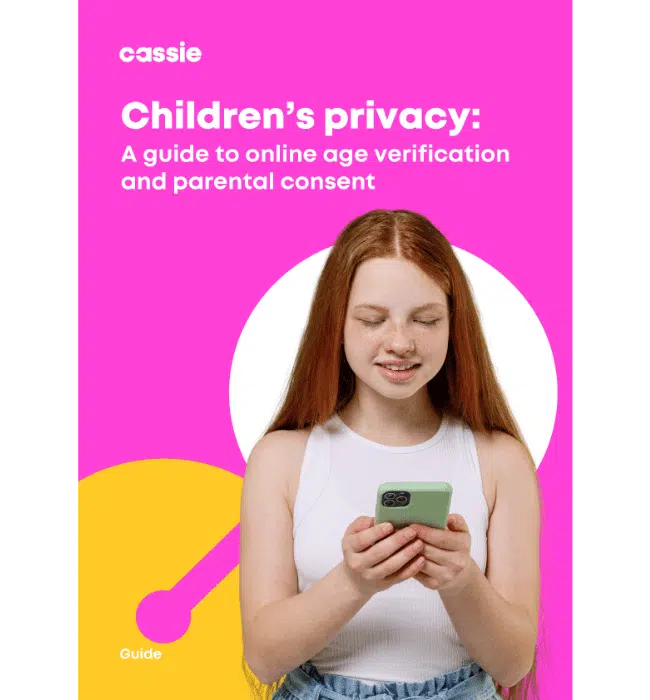Age Verification and Parental Consent Tracking:
The importance of protecting minors’ privacy
Posted: August 15, 2024
Current privacy concerns for minors
With the rise of digital connectivity, minors are often exposed to online environments that may not always be safe. Privacy concerns for minors include the risk of exposure to inappropriate content, cyberbullying, and the potential misuse of their personal data, highlighting the necessity for strong privacy protections to ensure that minors can safely navigate the internet.
Key regulations and jurisdictions focusing on this issue
To address the growing concerns about minors’ privacy online, several comprehensive regulations have been established across different regions. These regulations aim to create a safer digital environment for children by setting stringent guidelines and standards for the collection, use, and protection of their personal information.
- In the United States, the Children’s Online Privacy Protection Act (COPPA) sets strict guidelines for the collection and use of personal information from children under 13. COPPA requires websites and online services to obtain verifiable parental consent before collecting, using, or disclosing personal information from children.
- In the European Union, the General Data Protection Regulation (GDPR) includes specific provisions for the protection of children’s data. Article 38 of the GDPR mandates that the processing of personal data of children under 16 is only lawful if consent is given or authorized by the holder of parental responsibility. Member States can lower this age to 13.
- In the United Kingdom, the Age Appropriate Design Code (also known as the Children’s Code) emphasizes the importance of safeguarding minors’ privacy. This code sets out 15 standards that online services must follow to ensure they are appropriate for children, including measures for data minimization, transparency, and the best interests of the child.
Mechanisms for Age Verification
Different methods used for age verification
Various methods are employed to verify a user’s age online. One common approach is self-declaration, where users provide their date of birth. While this method is easy to implement, it is also prone to falsification. Another method is document verification, which involves users uploading a government-issued ID – organizations have proven this method to be more reliable but also reflected that the process can be cumbersome and raises privacy concerns.
Biometric verification, such as facial recognition or fingerprint scanning, is another option, this type of verification tends to be highly accurate but may be seen as intrusive and expensive to the end users. Lastly, debit card verification requires users to provide debit card information to confirm their age, whilst this method is effective it excludes minors who do not have access to debit cards.
Each of these methods has its own set of pros and cons. Self-declaration is simple and easy to implement but is easily falsified, making it less reliable. Document verification, while more reliable, can be inconvenient for users and may raise privacy concerns due to the sensitive nature of the documents involved. Biometric verification offers high accuracy and security but can be perceived as intrusive and is often costly to implement. Credit card verification is effective in confirming age but excludes minors who do not have access to credit cards, potentially limiting its applicability.
Whilst there is no one-size-fits-all solution for age verification, a combination of these methods, tailored to the specific needs and context of the service, can provide a balanced approach to ensuring minors’ safety and privacy online. By carefully considering the strengths and weaknesses of each method, organizations can implement a reliable age verification processes that protect minors while maintaining user convenience and trust.
Parental consent tracking
Importance of obtaining parental consent
Obtaining parental consent is crucial for ensuring that minors engage with online content and services in a safe and secure manner, the process not only provides an additional layer of protection but also ensures that parents are fully aware of and approve their children’s online activities. By involving parents in the consent process, we can safeguard minors from potential risks such as exposure to inappropriate content, cyberbullying, and the misuse of personal data.
Parental consent ensures that minors’ interactions with digital platforms are monitored and controlled by their guardians, providing a safer online environment for children to explore in. This proactive approach helps to build trust between parents, children, and online service providers, ultimately contributing to a more secure digital experience for young users.
Technologies and processes used to track and verify parental consent
Various technologies and processes are employed to track and verify parental consent, each offering different levels of security and convenience. Digital consent forms are a common method, where parents fill out and submit consent forms online, providing a straightforward and accessible way to obtain consent. Email verification involves sending a verification link to the parent’s email address, which they must click to confirm their consent, adding an extra layer of authentication.
Phone verification is another method, where parents receive a verification code via SMS or a phone call, which they then enter to confirm their consent. This method is effective in ensuring that the consent is genuine and immediate. Biometric verification, such as using fingerprint or facial recognition, is also used to confirm parental consent. This method is highly secure and reliable, though it may be seen as more intrusive and requires advanced technology.
By leveraging these technologies, organizations can ensure that parental consent is obtained and verified in a manner that is both secure and convenient, thereby enhancing the safety and privacy of minors online.
Examples of successful implementation of age verification and parental consent tracking
- YouTube Kids: YouTube Kids employs a combination of self-declaration and parental consent mechanisms to create a safe environment for children. Parents are required to set up the account and provide consent, ensuring that the content accessed by minors is appropriate for their age group, this combined approach helps to maintain a secure and child-friendly platform.
- Epic Games: Epic Games utilizes document verification and parental consent tracking to comply with both COPPA and GDPR requirements. By requiring users to upload government-issued IDs and obtaining verifiable parental consent, Epic Games ensures that minors are protected while engaging with their gaming service, helping to safeguard children’s privacy and security.
- Disney+: Disney+ employs parental controls to provide age-appropriate content to younger viewers. Parents can set up profiles for their children, restricting access to certain types of content based on age ratings, ensuring that children only view content that is suitable for their age group, enhancing their online safety.
Where does Consent and Preference Management fit into age verification and parental consent tracking?
Consent and preference management platforms (CPMs) are integral to the process of age verification and parental consent tracking. CPMs provide a solution that enable organizations to gather and manage consent in a compliant manner, ensuring strict adherence to age verification rules and privacy regulations. By integrating a CPM, organizations can streamline the process of obtaining and verifying parental consent, maintain accurate records, and provide transparency to users about how their data is being used.
CPMs not only facilitate compliance with legal requirements but also build trust with parents and guardians. By offering clear and transparent processes, they reassure parents that their children’s privacy is being protected whilst helping organizations to efficiently handle consent revocation and updates, ensuring that parental permissions are always current and accurately reflected in their systems.
Incorporating these platforms into age verification and parental consent tracking processes allows organizations to create a secure and compliant environment for minors. This proactive approach not only safeguards children’s privacy but also enhances the overall user experience by providing a seamless and trustworthy interaction for both parents and children.
Final thoughts
As the online environment continues to transform, it is organizations must remain vigilant and proactive in protecting the youngest and most vulnerable users online. By adopting strong age verification and parental consent tracking mechanisms in collaboration with a flexible consent and preference management platform, organizations can ensure a secure and compliant environment for minors to explore and engage with digital content safely. The implementation of these measures will in turn provide safer online environment for children, leveraging a combination of methods and technologies to protect their privacy and security.
You can learn more about Age Verification and Parental Consent Tracking in the latest Gartner Hype Cycle for Privacy 2024.

Children’s privacy: A guide to online age verification and parental consent
In a world where everyone seems to be always online, potential pitfalls abound, those who are most vulnerable may be the least prepared to navigate them on their own.
As kids increasingly navigate the online world for learning, socializing, and fun, it’s vital to acknowledge and address the risks they may encounter.
In this guide, we’ll take a closer look at the legal landscape and how brands can take conscious steps to ensure children’s privacy is protected online.

